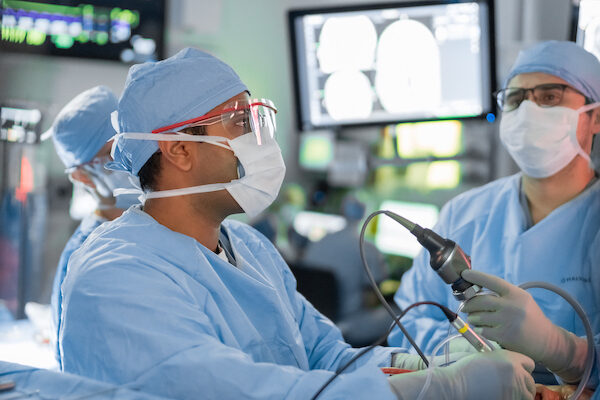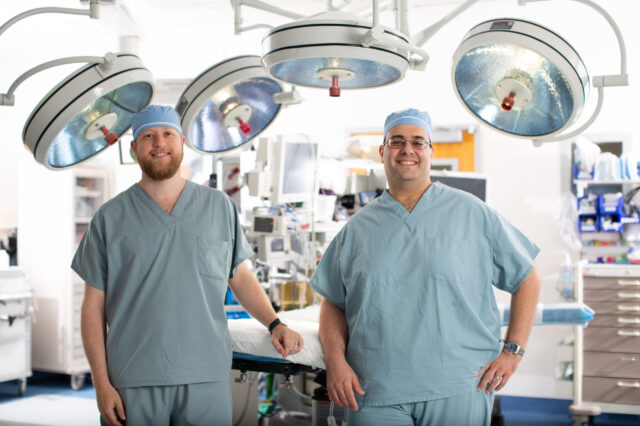Acoustic neuroma
Acoustic neuromas are nonmalignant fibrous growths, usually originating from the balance nerve. Spread to other parts of the body is extremely rare. They constitute 6-10% of all brain tumors. Most of these growths are found in only one ear, but occasionally both ears may be affected. They’re located deep inside the skull and are adjacent to vital brain centers. UF Health treats several acoustic neuromas (or vestibular schwannomas) yearly and has a dedicated neurosurgical hospital with state-of-the-art operating rooms and specialized nursing staff.
Learn more about acoustic neuromas.
Cushing’s disease
When the pituitary gland releases too much adrenocorticotropic hormone (ACTH), it leads to a condition called Cushing’s disease. This condition stems from a tumor in the pituitary gland that is usually benign, or noncancerous. The tumor’s overproduction of ACTH leads to the adrenal gland making too much cortisol. Cushing’s disease can bring about diabetes, high blood pressure, depression, osteoporosis or other serious issues.
Learn more about Cushing’s disease.
Encephalocele/CSF Leak
An encephalocele is characterized by a projection of the brain and the membranes that cover it through openings in the skull. This sac-like protrusion can occur anywhere along the base of the skull from the nose, to the ear, to the back of the head. Encephaloceles can be associated with a leakage of fluid from around the brain, cerebrospinal fluid (CSF). CSF leaks typically appear as clear, watery drainage from the nose, ear or postnasal drip. CSF leaks may contribute to hearing loss, dizziness and headaches. Encephaloceles can be seen also in children stemming from a birth defect along the developing brain and spinal cord. At UF Health, patients benefit from a dedicated neurosurgical hospital with state-of-the-art operating rooms and specialized nursing staff.
Learn more about encephaloceles.
Endoscopic skull base surgery
Skull base surgeries can be conducted in two primary ways: traditional/open skull base surgery or endoscopic skull base surgery. Endoscopic skull base surgery is a minimally invasive procedure in which small instruments are passed through the skull to see, repair and remove structures in the skull base.
This type of procedure allows surgeons to perform complex procedures more effectively and with less morbidity. Surgeons also have the option to gain access through the nostril without a visible incision.
Learn more about endoscopic skull base surgery.
Meningioma
Meningiomas account for about 20-30% of primary brain tumors (i.e., tumors that originate in the head), and there are roughly 20,000 primary brain tumors diagnosed each year in the U.S. These tumors do not originate from the brain tissue itself but arise from the meninges (the membranes that surround the brain and spinal cord). The physicians at the UF Health Comprehensive Skull Base Surgery Center work with a team approach to manage these complex tumors. Using leading-edge surgical techniques, including endoscopic approaches, radiation strategies and novel medical therapies, UF Health physicians are helping patients achieve cures.
Pediatric skull base services
In close collaboration with UF Health Shands Children's Hospital, our distinguished pediatric neuromedicine program provides care for patients from birth to age 21 and select adults with congenital neurological disorders.
The UF Health Comprehensive Skull Base Surgery Center in Gainesville specializes in treating pediatric patients with pituitary and skull base conditions.
Learn more about our pediatric skull base services.
Pituitary tumor
The pituitary gland, or “master gland” as it’s sometimes referred to, is located at the base of the brain and releases substances that govern the basic functions of growth, metabolism and reproduction. A tumor in the acorn-sized pituitary gland can trigger symptoms in one of a few ways: by releasing too much of a hormone; by preventing the release of enough hormone due to its pressure on the gland; by growing and pressing on the structures surrounding the gland, such as the nerves to the eyes. UF Health performs over 50 pituitary operations each year, totaling more than 1,100 to date.
Learn more about pituitary tumors.
Prolactinoma
A prolactinoma is a noncancerous (benign) pituitary tumor that produces a hormone called prolactin, which is a hormone that triggers the breasts to produce milk (lactation). This results in too much prolactin in the blood. Prolactinoma is the most common type of pituitary tumor (adenoma) that produces a hormone. It makes up about 30% of all pituitary adenomas. Almost all pituitary tumors are noncancerous (benign).
Learn more about prolactinoma.
Stereotactic radiosurgery
Stereotactic radiosurgery (SRS) is a form of radiation therapy that focuses precise, high-energy X-rays on a small area of the body. Although it’s called radiosurgery, it’s not a surgical procedure in the traditional sense as there is no incision. As a radiation therapy treatment technique, SRS uses 3D imaging to pinpoint high doses of radiation to the intended area with minimal impact on the surrounding healthy tissue. The standards that UF has developed for accuracy, quality assurance, patient follow-up, dosing, etc. have become standards around the world. On a national level, we’ve also developed novel radiosurgery equipment/treatment paradigms that are used across the country.
Learn more about stereotactic radiosurgery.
Transsphenoidal surgery
The most common way to remove pituitary tumors, transsphenoidal surgeries are done through the sphenoid sinus, which is a hollow space in the skull behind the nasal passages and below the brain. One advantage to this minimally invasive procedure is that the brain is not touched at all, so brain damage is highly unlikely. There are also fewer side effects and no visible scar.


